
views
We present here a simplified practise of this Pranayama that is more suitable to the modern man or householder.
BASICS OF WALKING PRANAYAMA
This Pranayama, as the name suggests, is done while walking. ‘Bhraman’ in Sanskrit means moving around and often refers to a stroll or walk. ‘Pranayama’ is the control of ‘prana’ — i.e. life-force or vital energy — through the regulation of breath. So, in effect, Walking Pranayama is the control of breath that we weave naturally into our walking routine.
Here, we are combining the benefits of walking and Pranayama. The outdoor breathing in green environs is beneficial as the air is rich in oxygen. “You will be invigorated and innervated quickly to a considerable degree,” Swami Sivananda has promised.
Unlike other Pranayamas that are done sitting and sometimes in lying positions and require making time, having a secluded space and accessories like yoga mat, etc., Bhraman Pranayama requires hardly any extra effort, since most people already have walking routines that they follow. It is best done just after sunrise or before sunset.
STEPS OF NEW-GEN BHRAMAN PRANAYAMA
Choose green surroundings, especially ones with big trees as those help to maximise oxygen intake. Otherwise, any park, walking track, or flat surface is adequate. Ensure the path is not crowded, in the beginning at least, until the practice becomes a habit.
1. Begin walking at a slow and comfortable pace with even steps. Remember to keep the spine straight, shoulders relaxed and arms moving naturally with the body.
2. Once the pace has steadied and acquired rhythm, gently get the breath into the picture. Watch the inhalation and exhalation for a couple of rounds.
3. Next, deeply inhale while counting four steps. Exhale completely, while walking six steps. (Keep a count that is comfortable; sometimes an inhalation of three and exhalation for five steps is suggested, or even inhaling for three and exhaling for six.)
4. Thus, breathing and movement of the body is coordinated. Initially it may feel awkward, but soon it will start flowing easily and become smooth. Avoid the use of any music or external distraction and keep the mind on the breathing.
5. Carry on for five minutes to begin with and increase it gradually to ten and then further to longer durations.
6. The next step is to be introduced at a later stage and is optional: chant OM or any other preferred mantra along with the steps. So, for example, chant four OM while breathing in and six OM when breathing out.
7. Practise this daily.
FEEL THE DIFFERENCE ONCE YOU START PRACTISING
1. The deep breaths ensure good oxygenation to the lungs, bringing in all benefits of Pranayama techniques. It increases the flow of energy through the body; improves stamina and endurance.
2. We don’t realise how irregular our usual breathing is; our mind and thoughts directly affect breathing. Regular practice of pranayama establishes correct breathing rhythm.
3. It helps the mind get one-pointed and leads to good concentration.
4. Pranayama controls vital energy and nourishes internal organs. As Prana from the atmosphere enters our bodies through the breath, it brings in vitality, good appetite, strength, cheerfulness and courage.
5. For depression, this immediately brings in positive energy and a sense of elevation and joy.
6. Yogis tell us that Pranayama just before writing something or other creative activities brings out beautiful and original ideas.
AN AUTOMATIC EXERCISE IN MINDFULNESS
As we focus on the steps while breathing, this is in itself a practice in mindfulness. With the mind already thus focussed, it doesn’t get distracted and there’s no need to bring it back time and again. Being aware of and observing the breath is, in fact, a form of meditation. That said, our attention must solely be on breathing, not paying heed to whether it is turning into a meditative state. Once we gain practice, the body starts to feels light.
According to Swami Sivananda, ‘Sagarbha Pranayama’ i.e. with mental chanting or japa is “one hundred times more powerful than the ‘Agarbha Pranayama’, which is plain i.e. without japa”. The japa can be OM or Gayatri mantra, otherwise according to one’s faith, or a Guru mantra, he has suggested.
AVOID
1. Don’t do this Pranayama when you are tired.
2. Avoid taking a bath for at least half an hour after practice.
3. If sweating, avoid getting exposed to cold air or breeze.
Note: This is only for the sake of information; retention of breath is not advised for the modern man and under no circumstance, without the guidance of a teacher.
The author is a journalist, cancer survivor and certified yoga teacher. She can be reached at [email protected].

















Comments
0 comment